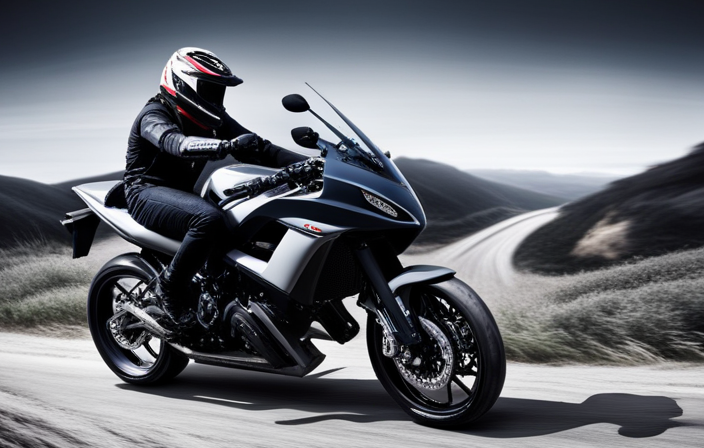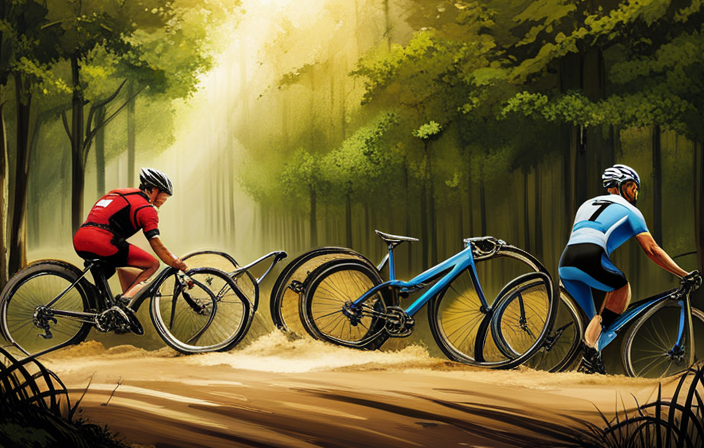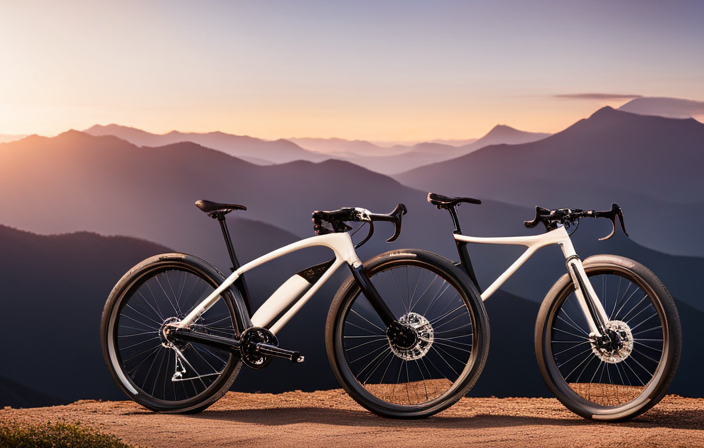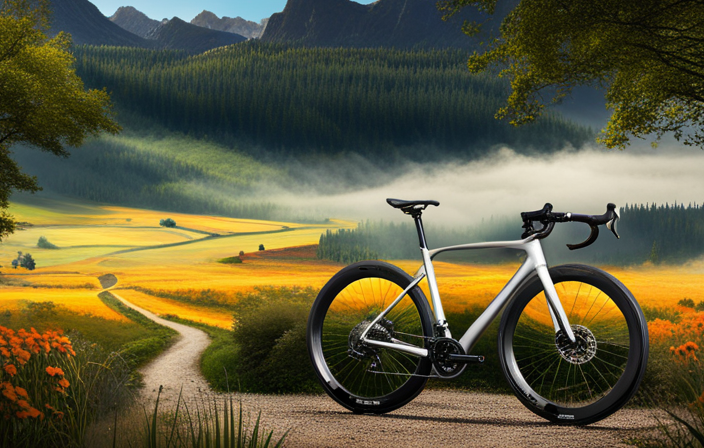Navigating the vast world of cycling can be overwhelming when it comes to choosing the perfect bike for gravel roads. It’s akin to maneuvering through a maze, where each twist and turn comes with its own set of obstacles and factors to consider.
But fear not, fellow cyclist! This article aims to shed light on this perplexing question – what type of bike is best for gravel road: mountain or road?
So grab your helmet, tighten those laces, and let’s dive into the exciting world of gravel road biking!
Key Takeaways
- Gravel road surface conditions and maintenance should be considered when choosing a bike for gravel road riding.
- Pros and cons of mountain bikes and road bikes should be evaluated to determine the best option for gravel road riding.
- Hybrid bikes offer versatility for both road and off-road riding, making them a good choice for gravel road cycling.
- Modifying your bike for gravel road riding, such as selecting the right tires, lowering tire pressure, and upgrading gearing and braking systems, can enhance your experience.
Understanding the Terrain of Gravel Roads
Understanding the terrain of gravel roads can help determine which type of bike is best suited for them. Gravel roads can vary greatly in terms of surface conditions and maintenance. Some gravel roads may be well-maintained, with a smooth and compacted surface, while others may have loose rocks, potholes, or washboard sections. It is important to consider these factors when choosing a bike for riding on gravel roads.
For riders who enjoy long-distance adventures on gravel roads, such as bikepacking trips, a mountain bike can be a great option. Mountain bikes are designed to handle rough terrains and offer excellent stability and control. They typically feature wider tires with aggressive tread patterns that provide better traction on loose surfaces like gravel.
However, it’s worth noting that mountain bikes also have their drawbacks when it comes to riding on gravel roads. The wide tires can create more rolling resistance on smoother surfaces, making it harder to maintain higher speeds. Additionally, the suspension systems found on most mountain bikes can absorb some pedaling power, resulting in less efficiency compared to road bikes.
In conclusion, understanding the terrain of gravel roads is crucial in selecting the right type of bike for your needs. While mountain bikes excel in handling rough terrains like those found on many gravel roads, they may not offer optimal performance in terms of speed and efficiency.
The Pros and Cons of Mountain Bikes for Gravel Roads
Consider the advantages and disadvantages of using a mountain bike on gravel roads. When it comes to tackling gravel roads, mountain bikes can offer some benefits but also come with their drawbacks. One advantage is that mountain bikes are designed to handle rough and uneven terrain, making them well-suited for gravel roads. The modified suspension on mountain bikes helps absorb shocks and vibrations, providing a smoother ride. Additionally, the wider tires provide better traction and stability on loose surfaces.
However, there are a few things to keep in mind when using a mountain bike on gravel roads. Firstly, evaluating bike fit is crucial as an ill-fitting bike can lead to discomfort or even injury during long rides. It’s important to ensure that the frame size, seat height, and handlebar position are suitable for your body proportions. Secondly, while the suspension may be beneficial in absorbing shocks, it can also result in energy loss due to unnecessary bouncing on smoother sections of the road.
Transitioning into the subsequent section about ‘the pros and cons of road bikes for gravel roads’, it’s worth exploring how road bikes differ from mountain bikes in terms of performance and suitability for gravel terrains without compromising comfort or efficiency.
The Pros and Cons of Road Bikes for Gravel Roads
Road bikes have their own advantages and disadvantages when it comes to navigating gravel terrain. While they may not be designed specifically for off-road cycling, road bikes can still be modified to handle gravel roads effectively.
One advantage of using a road bike on gravel is its lightweight construction, which allows for faster speeds and easier maneuverability. Additionally, the narrow tires of a road bike can provide better traction on loose surfaces compared to wider mountain bike tires.
However, there are some downsides to using a road bike on gravel roads. The thin tires that make road bikes efficient on pavement can also make them more susceptible to flats and damage from rough terrain. The rigid frame of a road bike may also lead to a less comfortable ride over bumpy surfaces.
To optimize a road bike for gravel roads, modifications can be made such as installing wider tires with lower pressure for improved stability and shock absorption. Choosing the right tires is crucial, as they should have enough tread to grip loose surfaces without compromising speed on smoother sections.
Considering these pros and cons, the decision between a mountain bike and a road bike ultimately depends on various factors such as personal preferences, riding style, and the specific conditions of the gravel roads you plan to tackle next.
Factors to Consider When Choosing Between a Mountain Bike and a Road Bike
When choosing between a mountain bike and a road bike, you should take into account factors such as your preferred terrain and the type of riding experience you are looking for.
Understanding Gravel Road Conditions:
- Gravel roads can be rough and unpredictable, with loose surfaces and uneven terrain. A mountain bike’s wide tires and suspension make it better equipped to handle these conditions compared to a road bike.
- However, road bikes can still be ridden on gravel roads with caution. The key is to choose the right tires that offer more grip and durability for off-road riding.
Benefits of a Hybrid Bike for Gravel Roads:
- If you’re someone who enjoys both road cycling and off-road adventures, a hybrid bike might be the ideal choice. It combines features of both mountain bikes and road bikes, offering versatility for different terrains.
- Hybrid bikes typically have wider tires than road bikes but are not as heavy or rugged as mountain bikes. They provide a good balance between speed on pavement and stability on gravel roads.
Considering these factors will help you make an informed decision about whether to go for a mountain bike, road bike, or hybrid bike when riding on gravel roads.
In the next section, we will explore tips for modifying your chosen bike to enhance its performance on gravel roads without compromising safety or comfort.
Tips for Modifying Your Bike for Gravel Road Riding
When it comes to modifying your bike for gravel road riding, there are a few key points to consider.
First, changing tires and adjusting tire pressure can greatly improve your bike’s performance on gravel surfaces.
Adding suspension or damping systems can also help absorb the bumps and vibrations that come with off-road riding.
Lastly, upgrading your gearing and braking systems can provide better control and efficiency when navigating through rough terrain.
These modifications can make a significant difference in your overall riding experience on gravel roads.
Changing Tires and Tire Pressure
To optimize performance on gravel roads, it’s essential to adjust tire pressure and change tires accordingly. Here are three key considerations when it comes to changing tires and tire pressure:
-
Tire Selection: Choosing the right type of tire for gravel road riding is crucial. Look for tires with a wider tread pattern and more aggressive knobs to provide better traction on loose surfaces.
-
Tire Pressure: Lowering your tire pressure can improve grip and comfort on gravel roads. It allows the tires to conform better to uneven surfaces, resulting in increased traction and reduced vibrations.
-
Tubeless Setup: Consider converting your tires to a tubeless setup, as it offers several advantages for gravel riding. It reduces the risk of punctures, allows lower tire pressures without pinch flats, and provides a smoother ride.
By adjusting tire pressure and changing tires appropriately, you can significantly enhance your bike’s performance on gravel roads.
Next, we’ll explore the importance of adding suspension or damping systems for an even smoother ride.
Adding Suspension or Damping Systems
Adding suspension or damping systems can greatly improve the comfort and performance of your ride on uneven surfaces.
One of the main benefits of suspension forks is that they absorb the impact from bumps and rough terrain, reducing the strain on your body and allowing for a smoother ride.
They also help to maintain traction by keeping your wheels in contact with the ground, enhancing control and stability.
When choosing the right damping system, it’s important to consider factors such as the type of riding you’ll be doing and your personal preferences.
Different systems offer varying levels of adjustability, allowing you to fine-tune the amount of suspension or damping based on your needs.
Upgrading gearing and braking systems is another crucial aspect to enhance your overall biking experience, providing better control and responsiveness.
Upgrading Gearing and Braking Systems
Upgrading the gearing and braking systems can significantly enhance your overall biking experience. When it comes to upgrading suspension, it’s important to choose the right handlebars that suit your riding style and preferences. The table below outlines some popular options for both gearing and braking upgrades:
| Gearing Upgrades | Braking Upgrades | Handlebar Options |
|---|---|---|
| Wide range cassette for better climbing ability | Hydraulic disc brakes for improved stopping power | Drop bars for a more aerodynamic position |
| 1x drivetrain for simplicity and weight savings | Larger brake rotors for increased heat dissipation | Flat bars for a more upright riding position |
| Electronic shifting for precise gear changes | Dual-piston calipers for better modulation and control | Riser bars for added comfort on rough terrain |
By upgrading these components, you’ll be able to tackle gravel roads with ease and confidence. Next, we’ll discuss how to test ride and evaluate different bikes suited for this type of terrain.
Test Riding and Evaluating Different Bikes for Gravel Roads
When test riding and evaluating different bikes for gravel roads, it’s crucial to consider factors such as tire width, frame geometry, and suspension options. These features play a significant role in determining the bike’s performance and comfort on rough terrain. Evaluating bike features involves comparing different bike brands to find the one that suits your needs best.
One important factor to consider is tire width. Gravel roads can be unpredictable, with varying levels of loose gravel and uneven surfaces. Wider tires provide better traction and stability, allowing you to navigate these conditions with ease.
Additionally, frame geometry plays a vital role in how the bike handles on gravel roads. A more relaxed geometry provides a more comfortable ride, while a more aggressive one offers better responsiveness.
Suspension options are also worth considering when choosing a bike for gravel roads. While full suspension mountain bikes offer excellent shock absorption on rough terrains, they may not be necessary if you primarily ride on smoother gravel roads. On the other hand, rigid frames or front suspension forks can still provide sufficient comfort without adding unnecessary weight.
In conclusion, when test riding and evaluating different bikes for gravel roads, it’s essential to assess aspects like tire width, frame geometry, and suspension options carefully. These factors will help determine which bike is the best fit for your needs before moving onto finding the right size and fit for your bike.
Finding the Right Fit and Size for Your Bike
To ensure optimal comfort and performance, it is crucial to find the right fit and size for your chosen bicycle. Bike fit refers to how well the bike matches your body’s measurements and proportions, while bike size pertains to the frame dimensions that suit your height and build.
When it comes to gravel road biking, finding the perfect fit and size becomes even more important due to the varied terrain and longer rides involved.
When looking for a bike, consider getting a professional fitting session at a local bike shop. A trained fitter will analyze your body’s biomechanics, assess flexibility, and take measurements to determine the ideal fit. They will adjust components like saddle height, stem length, and handlebar reach to optimize comfort and efficiency.
Additionally, choosing the correct bike size is pivotal for an enjoyable riding experience on gravel roads. A properly sized frame ensures proper weight distribution between wheels, stability in handling rough terrains, and efficient power transfer when pedaling uphill or accelerating.
Once you have found the right fit and size for your bike, you can confidently explore gravel road trails and routes near you. By tailoring your bicycle specifically to your body dimensions, you’ll be able to tackle challenging terrains with ease while enjoying every adventure that awaits you on those dusty paths ahead.
Exploring Gravel Road Trails and Routes Near You
Once you’ve found the perfect fit and size for your bicycle, it’s time to start exploring nearby trails and routes suitable for gravel riding. One great way to discover new paths is by finding local gravel road races or events. These races not only provide a fun and competitive environment but also showcase some of the best gravel roads in the area. Participating in these events can help you meet other like-minded riders and gain valuable insights into popular routes.
Riding on gravel roads offers several benefits for training purposes. The uneven terrain provides a challenging workout, engaging different muscle groups compared to riding on pavement. It can improve your balance, stability, and bike handling skills. Gravel roads also tend to be less crowded than paved ones, allowing for uninterrupted training sessions.
When it comes to safety precautions and equipment for gravel road riding, there are a few essential items you should consider. Helmets are always a must to protect your head in case of falls or accidents. Additionally, wearing durable gloves with good grip ensures better control over your bike while navigating uneven surfaces. In the next section, we will delve deeper into these safety measures and explore the necessary equipment needed for enjoyable and safe gravel road riding adventures without missing out on any crucial steps.
Safety Precautions and Equipment for Gravel Road Riding
When it comes to exploring gravel road trails and routes near you, safety should always be a top priority. Riding on gravel roads can present its own set of challenges, so being prepared and equipped with the right gear is essential.
One important aspect of safety when riding on gravel roads is making sure your bike is properly modified for this type of terrain. Gravel-specific bikes are designed with features that enhance stability, control, and comfort on rough surfaces. These modifications may include wider tires with increased traction, stronger wheels to withstand the demands of off-road riding, and added suspension to absorb vibrations.
Equally important is having the proper gear for gravel road riding. This includes a well-fitting helmet to protect your head in case of a fall or collision, gloves to improve grip and cushion your hands from the impact of rough surfaces, and padded shorts for added comfort during long rides. Additionally, wearing bright colored clothing and using lights or reflectors can increase visibility and ensure other riders or drivers can see you clearly.
Now that we’ve covered the importance of safety precautions and equipment for gravel road riding, let’s delve into another exciting aspect: joining gravel road cycling communities and events.
Joining Gravel Road Cycling Communities and Events
If you’re interested in becoming part of the gravel road cycling community, consider joining local events and connecting with fellow riders. Participating in group rides not only adds to the sense of camaraderie but also offers numerous benefits for gravel road cyclists.
Here are some reasons why you should join gravel road cycling communities and events:
- Learn from experienced riders: Riding with more seasoned cyclists can provide valuable insights and tips on technique, gear, and navigation.
- Discover new routes: Group rides often explore different gravel roads, allowing you to discover hidden gems and expand your riding repertoire.
- Motivation and accountability: Being part of a community helps keep you motivated to ride regularly and push yourself to improve.
- Safety in numbers: Riding as a group provides an added layer of safety, especially on remote gravel roads where assistance may be limited.
To prepare for your first gravel road cycling event, there are a few key steps to take. Start by checking the event’s website or contacting organizers for information on course difficulty, terrain conditions, and required equipment. It’s crucial to have a well-maintained bike suitable for off-road riding. Additionally, practice riding on similar surfaces beforehand to get accustomed to handling loose gravel.
Transitioning into the subsequent section about maintenance and cleaning tips for gravel road bikes, it’s important to properly maintain your bike after participating in these events.
Maintenance and Cleaning Tips for Gravel Road Bikes
Make sure you regularly clean and maintain your gravel bike to keep it in optimal condition for future rides. Bike maintenance is an important aspect of owning any type of bike, and gravel bikes are no exception.
After each ride, it’s a good idea to give your bike a thorough cleaning. Start by washing off any dirt or mud using a hose or bucket of water. Use a soft brush or sponge to gently scrub the frame, wheels, and drivetrain to remove any grime. Pay special attention to the chain, as this is where most of the dirt accumulates.
Once your bike is clean, it’s time for some maintenance tasks. Check the tire pressure and adjust if necessary. Inspect the brakes for wear and make sure they are properly aligned. Lubricate the chain with a bicycle-specific lubricant, wiping off any excess oil afterwards. Lastly, check that all bolts are tight and secure.
By regularly cleaning and maintaining your gravel bike, you can extend its lifespan and ensure smooth rides every time.
Understanding the difference between gravel bikes and cyclocross bikes will help you make informed decisions about which type of bike is best suited for your needs.
Understanding the Difference Between Gravel Bikes and Cyclocross Bikes
Now that we’ve covered maintenance and cleaning tips for gravel road bikes, let’s dive into the difference between gravel bikes and cyclocross bikes.
As a cyclist who loves exploring off-road terrains, it’s important to understand the nuances between these two types of bikes.
Gravel bikes are specifically designed for long rides on mixed surfaces, offering stability and comfort. They have wider tires with lower pressure, which provides better traction on loose terrain.
On the other hand, cyclocross bikes are built for intense racing on obstacle-filled courses. They are lightweight and agile, allowing for quick maneuvering through tight corners and steep climbs.
When it comes to modifications, gravel bikes can be easily customized with additional accessories like pannier racks or fenders to accommodate different riding needs. Cyclocross bikes, however, are typically not as versatile in terms of modification options due to their specialized design for racing.
In terms of performance, gravel bikes excel in endurance rides over long distances with their relaxed geometry and stable handling. On the other hand, cyclocross bikes shine in short bursts of speed during races due to their aggressive geometry and responsive handling.
Understanding these differences will help you make an informed decision when choosing between a gravel bike or a cyclocross bike based on your specific riding style and preferences.
Now let’s move on to our next section where I’ll provide some recommendations for budget-friendly gravel road bikes…
Recommendations for Budget-Friendly Gravel Road Bikes
Looking for an affordable option to explore off-road terrains? Consider checking out some budget-friendly options for gravel road bikes. When it comes to finding a gravel road bike on a budget, there are a few things to keep in mind. First, consider the benefits of single speed gravel bikes. These bikes are simple and low-maintenance, making them great for beginners or those who prefer a minimalist approach. Additionally, they tend to be more affordable compared to geared options.
If you’re looking for even more cost savings, you might want to consider buying a used gravel road bike. There are several tips that can help you find the right bike at the right price. Firstly, do your research and understand what features and specifications you need in a gravel bike. This will help you narrow down your options and make a more informed decision when browsing through used listings.
To add depth and complexity to this discussion, here is a table comparing three budget-friendly gravel road bikes based on their key features:
| Bike Model | Frame Material | Gear System | Price Range |
|---|---|---|---|
| Bike 1 | Aluminum | Single Speed | $500-$700 |
| Bike 2 | Steel | 10-Speed | $800-$1000 |
| Bike 3 | Carbon Fiber | Shimano GRX Groupset | $1200-$1500 |
Now that we’ve discussed some budget-friendly options for gravel road bikes, let’s move on to expert advice and tips from experienced gravel road cyclists.
Expert Advice and Tips from Experienced Gravel Road Cyclists
If you want to become a skilled gravel cyclist, learn from experienced riders who can provide expert advice and valuable tips. One important aspect of gravel cycling is understanding how to modify suspension systems on your bike. Gravel roads can be bumpy and rough, so having the right suspension setup can greatly improve your comfort and control on these surfaces.
Experienced cyclists recommend adjusting the front fork to have slightly less compression and rebound compared to traditional mountain biking setups. This allows for better absorption of vibrations and bumps while maintaining stability.
Another valuable tip from experienced gravel road cyclists is to join cycling events in order to gain more experience and learn from others. These events provide opportunities for riders of all skill levels to come together, share knowledge, and push each other’s limits. Participating in races or group rides not only improves your skills but also introduces you to a community of like-minded individuals who are passionate about gravel cycling.
By modifying suspension systems and participating in cycling events, you’ll be well on your way to becoming a skilled gravel cyclist.
In the next section, we will discuss final thoughts and considerations that will help you make an informed decision when choosing the best type of bike for your needs.
Final Thoughts and Making Your Decision
In conclusion, considering all the advice and tips from experienced riders, you can now make an informed decision on which bicycle suits your needs. Evaluating bike performance is crucial when choosing a bike for gravel road riding. You need a bike that can handle the rough terrain and provide stability. Factors like tire width, frame material, and suspension play important roles in determining how well a bike performs on gravel roads.
When it comes to long distance rides, comfort becomes paramount. Look for features like relaxed geometry, wider tires for better shock absorption, and a comfortable saddle. These factors will ensure that you can ride longer distances without discomfort.
Here are five considerations to keep in mind when making your decision:
- Tire width: Opt for wider tires as they provide better traction and stability on gravel roads.
- Frame material: Consider lightweight materials like carbon fiber or aluminum for easier handling.
- Suspension: A front suspension fork or a full-suspension system can help absorb shocks on uneven surfaces.
- Gearing: Choose a wide range of gears to tackle steep climbs and maintain speed on flat sections.
- Accessories: Look for options to mount racks or fenders if you plan on carrying gear or riding in different weather conditions.
By evaluating these factors and considering your specific needs, you’ll be well-equipped to choose the best bike for your gravel road adventures. Happy riding!
Frequently Asked Questions
Can I use a mountain bike on gravel roads?
Yes, mountain bikes can handle gravel roads. They have sturdy frames and wide tires that provide stability and traction on uneven surfaces.
However, there are advantages to choosing a gravel bike over a mountain bike for gravel roads. Gravel bikes are specifically designed for long rides on mixed terrain, with features like relaxed geometry for comfort and wider gear ranges for better efficiency.
It ultimately depends on your preferences and the specific conditions of the gravel road you’ll be riding on.
Are road bikes suitable for riding on gravel roads?
Road bikes can be suitable for riding on gravel roads, but there are pros and cons to consider. A cyclocross bike is a good option as it offers the advantages of both road and mountain bikes. It has wider tires with more traction for rough terrains, making it ideal for gravel roads. However, it may not handle technical off-road sections as well as a dedicated gravel bike.
Exploring the benefits of using a gravel-specific bike on rough terrains is worth considering too.
What are the main differences between mountain bikes and road bikes for gravel road riding?
When it comes to gravel road riding, the differences between mountain bikes and road bikes become apparent.
Mountain bikes are like rugged explorers, built for rough terrains with their sturdy frames and wide tires.
On the other hand, road bikes are sleek speedsters designed for smooth pavement.
While both can handle gravel roads, a gravel bike is specifically engineered to excel in this terrain.
It offers a balance of stability, comfort, and versatility that makes it ideal for conquering various surfaces with ease.
How can I modify my bike to make it more suitable for riding on gravel roads?
To make my bike more suitable for riding on gravel roads, I can make a few modifications.
First, I would change the tires to ones that are specifically designed for gravel riding. These tires usually have a wider profile and deeper treads for better traction on loose surfaces.
Additionally, adding some form of suspension or shock absorption system can help smooth out the bumps and provide a more comfortable ride on rough terrain.
What are some recommended budget-friendly gravel road bikes?
When it comes to budget-friendly gravel road bikes, one interesting statistic is that hybrid bikes are often a popular choice.
While they may not be specifically designed for gravel riding, their versatility makes them suitable for various terrains.
The pros of using a hybrid bike for gravel road riding include affordability and the ability to handle both paved and unpaved surfaces.
However, they may lack certain features specialized gravel bikes offer, such as wider tires and more durable frames.
Conclusion
After exploring the pros and cons of mountain bikes and road bikes for gravel roads, it’s clear that there is no one-size-fits-all answer.
It ultimately depends on your personal preferences and the specific terrain you’ll be riding on. Like choosing between a sports car or a rugged SUV for an off-road adventure, each bike has its strengths and weaknesses.
Consider factors such as comfort, speed, stability, and versatility when making your decision. Remember to consult with experienced cyclists for their valuable insights before embarking on your gravel road journey.
Happy riding!
















